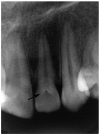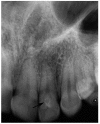A retrospective study of the prevalence and characteristics of dens invaginatus in a sample of the Turkish population
- PMID: 23229254
- PMCID: PMC3548641
- DOI: 10.4317/medoral.18285
A retrospective study of the prevalence and characteristics of dens invaginatus in a sample of the Turkish population
Abstract
Objective: The purpose of this study was to assess the prevalence of dens invaginatus and to classify the types of dens invaginatus in a sample of the Turkish population.
Study design: A retrospective study was performed using periapical and panoramic radiographs of 5355 patients who presented to the Department of Oral Diagnosis and Radiology at the Ondokuz Mayis University Dentistry Faculty between January 2009 and December 2010. Maxillary and mandibular anterior teeth were evaluated for the presence and characteristics of dens invaginatus. Statistical evaluation of the presence of dens invaginatus related to gender was performed by the Pearson chi-squared test.
Results: Dens invaginatus was observed in 116 of 4556 subjects, with a frequency of 2.5%. There was only one periapical lesion in teeth with type I dens invaginatus, but 8.1% of patients with type II and 87.5% of patients with type III dens invaginatus had apical periodontitis at the time of referral. There were 116 (72%) females and 32 (27%) males with dens invaginatus.
Conclusion: This data represents the only study carried out in a large population in Turkey, and no dens invaginatus was found in mandibular teeth. The most commonly observed type of dens invaginatus was type I (69.8%).
Figures



References
-
- Hulsmann M. Dens invaginatus: aetiology, classification, prevalence, diagnosis and treatment considerations. Int Endod J. 1997;30:79–90. - PubMed
-
- Oehlers FA. Dens invaginatus (dilated composite odontome). Variations of the invagination process and associated anterior crown forms. Oral Surg Oral Med Oral Pathol. 1957;10:1204–18. - PubMed
-
- Rushton MA. Invaginated teeth (dens in dente): contents of the invagination. Oral Surg Oral Med Oral Pathol. 1958;11:1378–87. - PubMed
-
- Hosey MT, Bedi R. Multiple dens invaginatus in two brothers. Endod Dent Traumatol. 1996;12:44–7. - PubMed
-
- Schwartz SA, Schindler WG. Management of a maxillary canine with dens invaginatus and a vital pulp. J Endod. 1996;22:493–6. - PubMed
MeSH terms
LinkOut - more resources
Full Text Sources
Other Literature Sources

